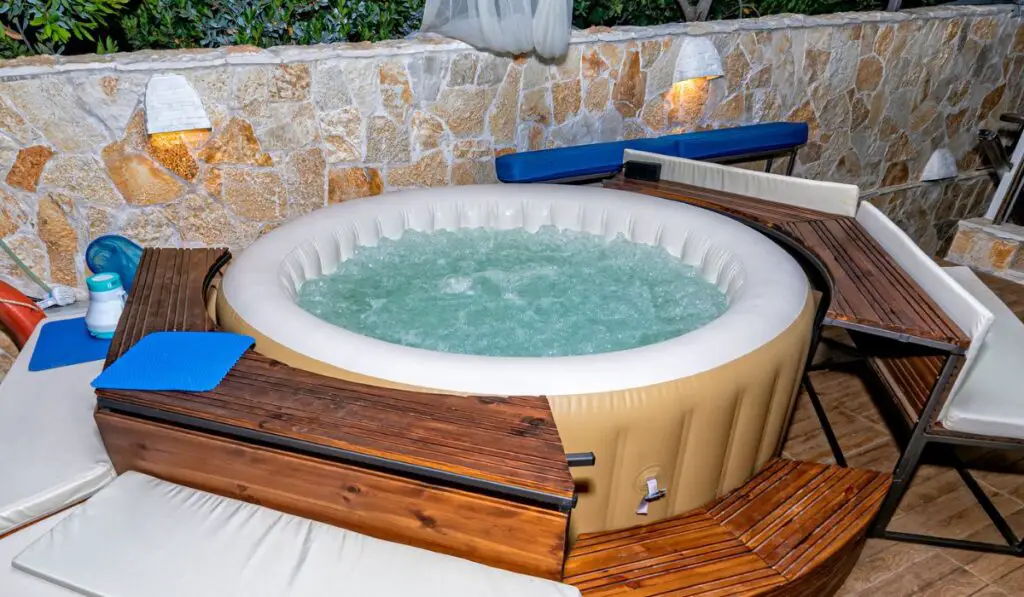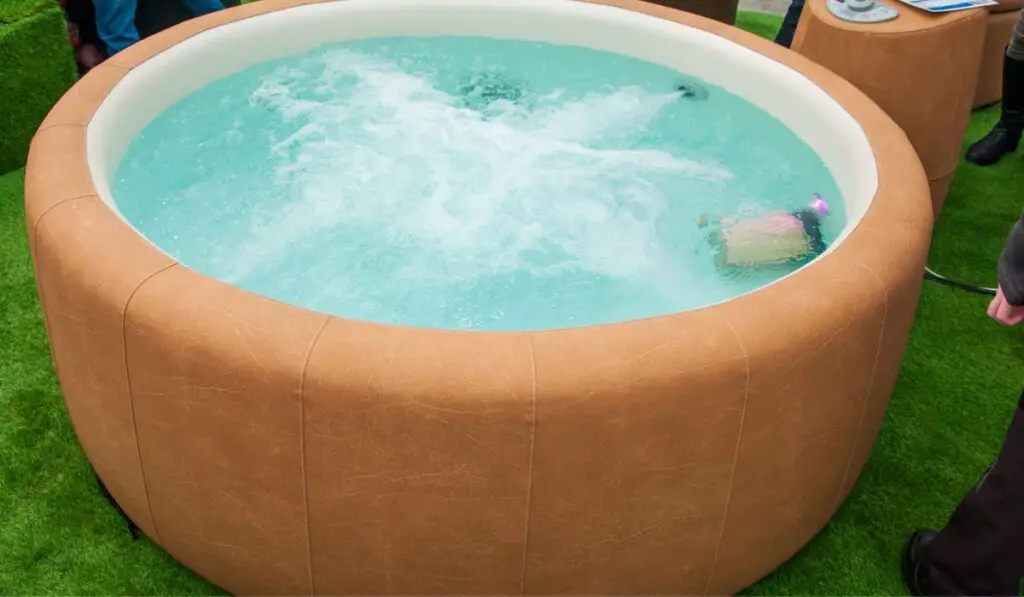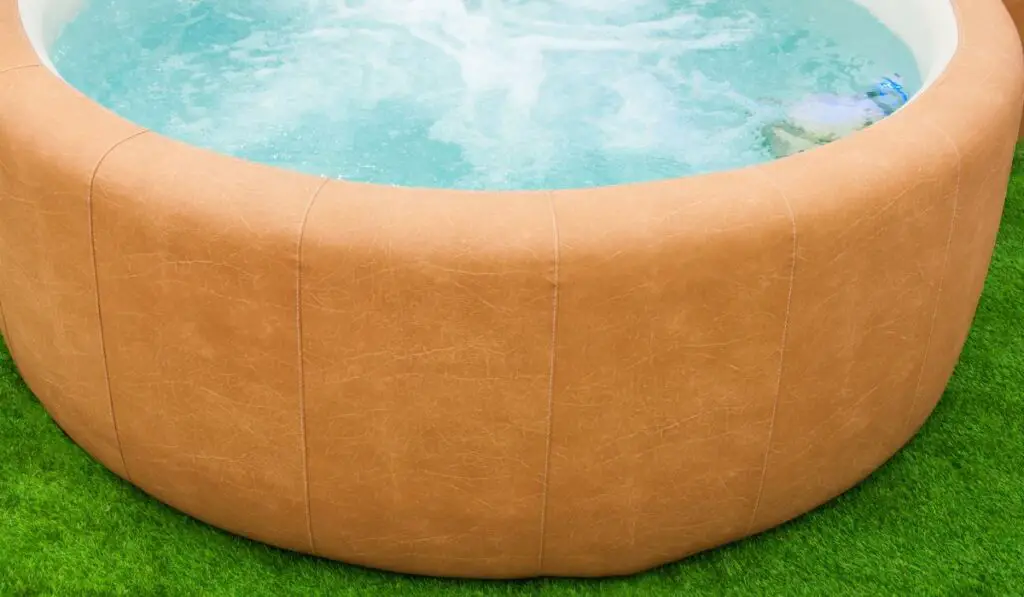One of the most important considerations when setting up an inflatable hot tub is the kind of foundation to use. Not all surfaces are equal, and using the wrong type of foundation can lead to a less-than-ideal experience.
The best foundation for an inflatable hot tub is a flat, level surface made of concrete, pavers, or decking. These materials are smooth and provide a stable base to support the weight of the tub and its occupants. Avoid using soil, grass, or sand, as these surfaces are uneven.
But there’s a lot more to consider than just the surface material. So we will take you through everything you need to know about setting up your hot tub on the proper foundation. As they say, failing to prepare is preparing to fail.
What Kind of Base is Best for an Inflatable Hot Tub?

The kind of base you choose for your inflatable hot tub will determine many things. Going with the proper base means:
- You’ll avoid having to replace your hot tub prematurely.
- Your hot tub will be more energy efficient.
- Your hot tub will experience fewer punctures and tears and will be safer.
- You will protect your hot tub from grass, bugs, and all sorts of damage.
Some materials can go under an inflatable hot tub; here are the most common ones.
Concrete Pad: The Most Durable Material
A concrete pad is one of the best choices for your inflatable hot tub. It’s durable, weatherproof, and will support the tub’s weight even when you are inside without any issues. You can either have a professional pour a concrete pad for you or do it yourself if you feel confident.
If you go the DIY route, here are a few things to keep in mind:
- Make sure you use concrete mix and not just regular cement. Concrete is much stronger and will last longer.
- You should also ensure the pad is at least 4” thick to support the weight of the hot tub and people.
- It’s a good idea to put some wire mesh in the concrete pad as well to reinforce it. Also, remember to construct it the same size as your pad.
Paving
Paving stones are another popular choice for hot tub bases. They’re easy to install, look great, and are durable. And if any stones become damaged, you can replace them without having to replace the entire base.
Place your pavers on a solid surface such as gravel or concrete pad and cement them to prevent movement. You may need to put something between the pavers and the hot tub to insulate and protect its plastic base.
Foam Sheets: Most Insulating During the Winter
Foam sheets are made using a combination of polystyrene and polyurethane. They’re available in different thicknesses, but the thicker the sheet, the better it insulates. Because of their insulation properties, these are ideal to use during the winter.
You can place foam sheets on any solid surface, and they will protect your hot tub from the cold ground. They’re also great at absorbing sound, so if you live in an area with a lot of noise, these could help to reduce it.
Like with pavers, you may need to put something in between the foam sheets and the hot tub to protect the tub’s base.
Tiles
Four types of tiles are typically used for hot tubs: foam, plastic, wooden, and rubber. All are strong, durable, and good-looking materials that will
- Foam tiles: An easy-to-install option for your hot tub base. They’re inexpensive and can be cut to fit any size or shape. Some are slip-resistant and ideal for placing your hot tub on a deck or patio. The StillCool Puzzle Exercise Floor Mat (on Amazon) is one of the best foam tiles on the market.
- Plastic tiles: Another popular choice. They’re also easy to install and available in various colors and styles. Like foam tiles, they can be cut to size, and some are slip-resistant.
- Wooden tiles: A more expensive option, but very durable—most people like them for their stylish finish. You’ll need to seal them to protect them from the water and weather.
- Rubber tiles: Mainly made from recycled tires. They’re a solid and durable option that can withstand heavy traffic. They’re also water and slip-resistant, which makes them ideal for hot tubs.
Wood Decking
A wood deck is an excellent choice if you have one already. It looks good and provides a stable surface for your tub. Just make sure that the deck can support the weight of the tub and people without sagging or collapsing.
If you’re building a deck specifically for your hot tub, use weather-resistant lumber such as cedar or redwood. If you want your deck to last longer, you can use composite materials that look like wood but won’t rot or degrade as quickly.
Carpet Padding
Yes, you can use carpet as a base for your hot tub. It’s not the most durable option, but it’s much cheaper than other materials. Use carpet padding as well, so the carpet doesn’t deteriorate quickly.
A considerable downside with carpet is it’s not water resistant, so it will absorb water and could start to mildew. As a result, you’ll need to replace it more often than other materials. Also, it may not be the best insulating option during the winter.
Plastic Base Pad
Plastic base pads have been used since time immemorial for hot tubs. They’re the simplest and most popular choice because they’re easy to install and inexpensive. Plus, they are long-lasting, which means they’ll serve you for a long time.
What to Consider When Choosing a Foundation for Inflatable Hot Tub

When choosing the best foundation for your inflatable hot tub, you should consider several factors. Here are the most important ones.
Cost
The cost of the foundation is one of the most important factors to consider. Of course, you don’t want to spend more than you have to, but you also want to ensure that the foundation is durable and will last.
Go for the most cost-effective option that meets your needs. One of the most budget-friendly options is a plastic base pad. You can also find foam tiles for a reasonable price. If you have the budget, wooden tiles or decking can be a good investment.
Installation
How easy is the foundation to install? Of course, if you’re not handy, you’ll want something easy to put together. But if you don’t mind a little DIY, you can save money in the long run by choosing a more complex foundation to install.
Some of the easiest foundations to install are foam tiles and plastic base pads. If you want something more stylish, wooden tiles can be a good option. But they can be more difficult to install.
Weight Capacity
You also need to consider how much weight the foundation can support. This is important because you don’t want the foundation to collapse under the weight of the hot tub and people.
Most foundations can support at least 1,500 pounds. But if you have a large hot tub or plan on having many people in it, you may want to choose a foundation that can support 2,000 pounds or more.
Water Resistance
Does the foundation absorb water? This is important because you don’t want the foundation to deteriorate. After all, it’s constantly wet.
Some materials, such as carpets, are not water resistant and will absorb water. This can lead to mold and mildew growth. Other materials, such as rubber tiles, are water-resistant and won’t be damaged by moisture.
Insulation
Lastly is the insulation factor. This is important because you don’t want the hot tub to lose heat and have to work harder to maintain the temperature. But, again, foam tiles and sheets provide the best insulation. Wood can also be a good insulator, but it’s not as effective as foam.
Carpets don’t insulate well and can cause the hot tub to lose heat. Plastic base pads provide some insulation but are not as effective as foam or wood.
Should You Place Your Hot Tub on Grass or Concrete?

While grass may seem like the more natural option for your hot tub, it can be quite damaging to both your hot tub and your lawn. The constant moisture from the hot tub can kill the grass underneath, while your hot tub’s weight (around 4000 lbs) can cause indentations in your lawn.
Concrete is a much better option for placing your hot tub. It is more durable and can withstand the weight of the hot tub without any issues. Plus, the smooth surface of the concrete will make it easier to keep your hot tub clean.
However, if you decide to place your hot tub on grass, use a foam pad or something similar to protect the lawn underneath.
Conclusion
All these materials have pros and cons and affect your inflatable hot tub in different ways. Choose a foundation based on your needs and preferences. If you need help picking the right one, feel free to ask us in the comments below.
